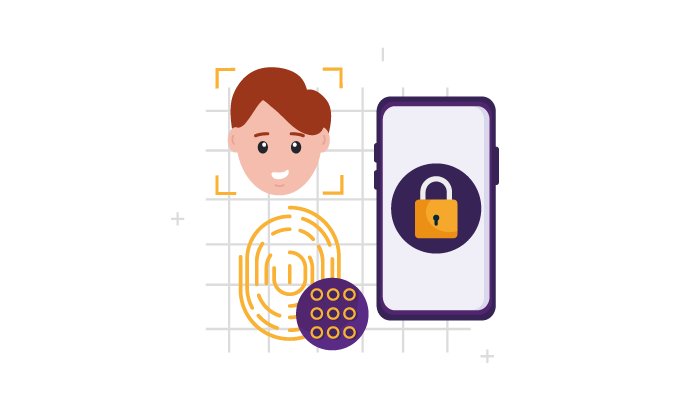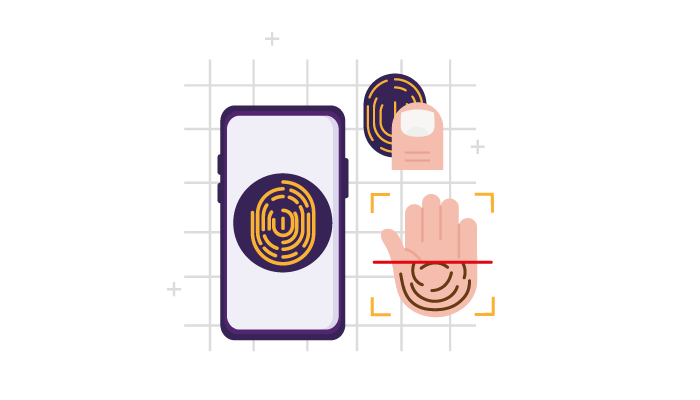Table of Contents
In an increasingly digital world, the security of user data has become a paramount concern. Apple has introduced two robust biometric authentication technologies, Face ID and Touch ID, which offer seamless and secure user experiences.
In this blog, we will delve into the implementation of Face ID and Touch ID authentication in iOS apps, exploring their significance in enhancing user security and privacy.
Understanding Face ID and Touch ID
Both face ID and Touch ID are essential feature seen in iOS app development. However, before we see how you can implement them in your solution, let’s discuss them briefly below:
Face ID

Face ID is an advanced facial recognition technology introduced by Apple. It utilizes the TrueDepth camera system, present in newer iPhone models, to capture and analyze facial data for authentication purposes.
Moreover, Face ID employs various sophisticated techniques, including depth mapping and infrared technology, to create a detailed map of the user’s face. It then compares this map with the securely stored facial data in the device’s Secure Enclave for authentication.
Touch ID

Though this has become a legacy technology, there are still apple devices which utilize touch ID, so let’s discuss it.
Touch ID is a fingerprint recognition technology that allows users to authenticate themselves by scanning their fingerprints. It relies on a capacitive touch sensor embedded in the home button of supported iOS devices.
In addition to this, Touch ID captures the unique patterns and characteristics of a user’s fingerprint and matches it against the fingerprint data securely stored in the device’s Secure Enclave.
Advantages of Face ID and Touch ID Authentication

Yes, both face ID and touch ID are amazing feature, but what are the advantages of using them in mobile app development for iOS? Well, there are plenty and in this section of the blog, we shall be discussing exactly those:
Enhanced Security
Face ID and Touch ID provide a higher level of security compared to traditional password-based authentication methods.
Moreover, Biometric data, such as facial features or fingerprints, is unique to each individual and difficult to replicate.
This makes it more challenging for unauthorized users to gain access to the device or the app, reducing the risk of security breaches.
Convenience and User Experience
Biometric authentication offers a seamless and user-friendly experience.
Users can unlock their devices or authorize app transactions quickly and effortlessly by using their face (Face ID) or fingerprint (Touch ID).
This eliminates the need to remember complex passwords or go through cumbersome authentication processes, leading to improved user satisfaction and productivity.
Rapid and Accurate Authentication
Face ID and Touch ID authentication are known for their speed and accuracy.
The advanced algorithms and hardware optimizations ensure swift and reliable biometric recognition, allowing users to access their apps or devices almost instantly.
Therefore, this saves time and provides a frictionless user experience.
Accessibility and Inclusivity
Biometric authentication methods like Face ID and Touch ID are inclusive and accessible to a wide range of users.
They can be particularly beneficial for individuals with mobility impairments or those who struggle with typing passwords.
The simplicity and intuitive nature of these technologies make them accessible to users of varying abilities.
Anti-Spoofing Measures
Face ID and Touch ID employ advanced anti-spoofing measures to protect against fraudulent attempts to deceive the system.
Face ID, for example, uses depth mapping and infrared technology to create a detailed facial map, making it difficult for spoofing techniques such as photographs or masks to bypass the authentication process.
These measures enhance the overall security of the biometric authentication system.
Privacy Protection
Apple has placed a strong emphasis on user privacy when implementing Face ID and Touch ID.
Biometric data is securely stored in the device’s Secure Enclave, a dedicated hardware component separate from the operating system.
This ensures that biometric information remains on the device and is not transmitted to external servers, mitigating the risk of unauthorized access to sensitive data.
App Integration and Flexibility
Face ID and Touch ID can be seamlessly integrated into iOS apps using the LocalAuthentication framework.
Mobile App Developers have the flexibility to customize the authentication flow based on their app’s requirements, such as implementing biometric authentication as the primary login method or using it for specific sensitive operations.
Consequently, this allows for a tailored and secure user experience within the app.
Trust and User Perception
By implementing Face ID and Touch ID authentication, developers can build trust and confidence among users.
Biometric authentication methods are widely recognized and trusted, providing users with the assurance that their personal information is well-protected.
This can result in increased user engagement, loyalty, and positive brand perception.
Implementing Face ID and Touch ID Authentication in iOS Apps

While you can find an app developer to do this for you, understanding how to implement FaceID and TouchID authentication in your iOS app will help you in the longer run.
Therefore, in this section of the blog, we shall be going through entire process of doing so, step by step:
1. Set Up Project and Capabilities
To begin implementing Face ID and Touch ID authentication in your iOS app, follow these initial steps:
- Open your project in Xcode and ensure that it targets iOS devices with Face ID or Touch ID capabilities.
- Enable the necessary capabilities in your app’s project settings. For Face ID authentication, enable the “Face ID” capability. For Touch ID authentication, enable the “Touch ID” capability.
2. Import the LocalAuthentication Framework
To access the Face ID and Touch ID authentication APIs, import the LocalAuthentication framework into your project.
Moreover, this framework provides the necessary classes and methods to interact with the biometric authentication system.
3. Check Device Support
Before implementing biometric authentication, determine whether the device supports Face ID or Touch ID. Use the canEvaluatePolicy(_:error:) method of the LAContext class to check for biometric authentication support.
Example code snippet for device support check:
let context = LAContext()
var error: NSError?
if context.canEvaluatePolicy(.deviceOwnerAuthenticationWithBiometrics, error: &error) {
// Biometric authentication is supported on this device
} else {
// Biometric authentication is not supported or is disabled
}
4. Request Biometric Authentication
To initiate biometric authentication, use the evaluatePolicy(_:localizedReason:reply:) method of the LAContext class. This method prompts the user to authenticate using Face ID or Touch ID, depending on the device’s capabilities.
Example code snippet for requesting biometric authentication:
let context = LAContext()
let reason = “Authenticate to access the app”
context.evaluatePolicy(.deviceOwnerAuthenticationWithBiometrics, localizedReason: reason) { (success, error) in
if success {
// Biometric authentication succeeded
} else {
// Biometric authentication failed or was canceled
if let error = error as NSError? {
// Handle specific error cases
}
}
}
5. Handle Authentication Results
The authentication result is returned in the success parameter of the completion closure provided in the authentication request.
If success is true, the biometric authentication was successful. Otherwise, you can handle the authentication failure or cancellation accordingly.
6. Provide Alternative Authentication Methods
In cases where biometric authentication fails or is unavailable, provide alternative authentication methods such as a passcode or username/password combination.
Moreover, tou can present the user with an option to switch to an alternative authentication method if the biometric authentication fails.
7. User Interface and Feedback
Design a user interface that guides the user through the biometric authentication process. Display clear instructions and feedback messages to inform the user about the authentication status. You can use animations or progress indicators to provide visual cues during the authentication process.
8. Error Handling and Recovery
Handle potential errors that may occur during biometric authentication.
Common errors include biometryNotAvailable (biometric authentication not available on the device), biometryNotEnrolled (no biometric data enrolled on the device), and biometryLockout (temporary lockout due to multiple failed authentication attempts).
Thus, provide appropriate error messages to the user and offer guidance on how to resolve the issue.
9. Secure Data Storage
When implementing Face ID or Touch ID authentication, ensure that sensitive data within your app is appropriately secured.
Utilize iOS’s built-in encryption mechanisms, such as the Keychain Services API, to securely store user credentials and other sensitive information.
This helps protect the data even if an unauthorized user gains access to the device.
10. Regular Updates and Maintenance
Lastly, stay updated with the latest iOS releases, security patches, and guidelines provided by Apple.
Regularly test your app’s biometric authentication implementation and address any issues or vulnerabilities that may arise.
By maintaining your app’s compatibility with the latest iOS versions, you can ensure a secure and reliable authentication experience for your users.
There are various iPhone app development tools that let you implement these feature easily. Speaking of which, let’s move to the next section and discuss some best practices for ensuring User Security
Best Practices for Ensuring User Security via FaceID and Touch ID

It goes without saying that if you are developing an app it is most important to ensure user security. Now, there are certain these that can help you do it. And in section of the blog, we shall be discussing just these things:
Data Encryption
To further enhance user security, it is vital to encrypt sensitive data stored within the app.
And utilize iOS’s built-in encryption mechanisms, such as the Keychain Services API, to securely store user credentials and other sensitive information.
Moreover, encryption adds an extra layer of protection, ensuring that even if an unauthorized user gains access to the device, the stored data remains encrypted and inaccessible.
Biometric Data Storage
Like we saw in this blog, Apple’s Face ID and Touch ID technologies ensure that biometric data remains secure by storing it in the device’s Secure Enclave, an isolated hardware component.
As developers, it is essential to respect user privacy and refrain from storing biometric data or transmitting it to external servers.
Therefore, by following Apple’s guidelines and best practices, such as not persisting biometric data beyond what is necessary for authentication, you can help build trust with users and ensures the integrity of their personal information.
Regular Updates and Security Patches
Lastly, keeping your app up to date with the latest security patches and iOS updates is crucial. Apple continually improves the security features of Face ID and Touch ID, addressing any vulnerabilities that may arise.
By promptly incorporating these updates into your app, you ensure that your users benefit from the most robust and secure authentication experience.
Conclusion
This is all you need to know about implementing security features like FaceID and TouchID into iOS apps. And if you need more help regarding the same, it’s highly recommended that you consult a mobile app development company like WeAppIt, who can help you with the same.
FAQ
Advantages include enhanced security, convenience, rapid authentication, accessibility, anti-spoofing measures, privacy protection, app integration flexibility, and the ability to build user trust.
Use the canEvaluatePolicy(_:error:) method of the LAContext class to check for biometric authentication support on the device.
Use the evaluatePolicy(_:localizedReason:reply:) method of the LAContext class to initiate biometric authentication and prompt the user to authenticate using Face ID or Touch ID.
Provide alternative authentication methods, such as a passcode or username/password combination, for cases where biometric authentication fails or is not supported.
Handle potential errors, such as biometryNotAvailable or biometryNotEnrolled, by providing appropriate error messages and guidance to the user on how to resolve the issue.
Design a user-friendly interface with clear instructions and feedback messages to guide the user through the authentication process. Visual cues, animations, and progress indicators can enhance the user experience.
Secure sensitive data within your app using encryption mechanisms like the Keychain Services API. This protects the data even if the device is compromised. Avoid storing or transmitting biometric data outside the device.





No Comments
Comments are closed.